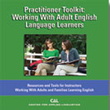Promoting education and achievement of adults learning English
Digests
Education for Adult English Language Learners in the United States: Trends, Research, and Promising Practices
Part I. Overview
Adult English language learners comprise a substantial proportion of the adult education population in the United States. According to recent statistics, 46% of all participants (1,101,082 out of 2,408,525) in state-administered adult education programs during 2006 –2007 were enrolled in English as a second language (ESL) classes (U.S. Department of Education, 2008b). This percentage does not include English language learners served in other sectors of the U.S. education system, such as those enrolled in adult basic education (ABE) or adult secondary education (ASE) classes.
Adult English language learners seek to improve their lives as individuals, community and family members, and workers. Many are settling into communities that have never had large populations of immigrants. To meet the increasing demand for English language instruction, existing adult education programs are expanding, and new programs are being established. Goal 5 of the strategic goals and objectives of the U.S. Department of Education (2002) mandates enhancing the quality of and access to postsecondary and adult education, and federal policy requires accountability for reporting program outcomes.
The Economic Opportunity Act of 1964 launched adult basic education programs and authorized instruction “toward the elimination of the inability of all adults to read and write English,” thus establishing services for English language learners within the federally funded adult education system. Subsequent legislation continued to support language instruction for immigrants and refugees, sometimes setting aside discretionary monies for services for specific populations (e.g., Cuban, Haitian, and Southeast Asian refugees) or for the development and teaching of specific content, such as citizenship and civics (U.S. Department of Education, 1991). Adult education classes for English language learners are offered through agencies that are eligible to receive federal adult education funds through the state delivery systems. In 2003–2004, ABE, ASE, and ESL programs were administered through local school districts (54%), community-based organizations (24%), community colleges (17%), and correctional and other institutions (5%) (U.S. Department of Education, 2005a).
Adult ESL services are also provided through other organizations that may or may not receive federal funding. These include faith- and volunteer-based organizations, museums, libraries, private language schools, workplace-based programs, and academic institutions that are financed through means other than federal funds (e.g., some community colleges). Significant numbers of adult English language learners are served in programs sponsored by community-based organizations and large national volunteer literacy organizations such as ProLiteracy, but reliable data are limited on the number of English language learners served through these organizations.
This paper describes education for adult English language learners in the United States. It gives an overview of the foreign-born population in the United States and provides a closer examination of those enrolled in adult ESL programs, including their access to and participation in these programs and the factors that affect their participation and success. Also discussed are the types of instructional programs that serve adult English language learners, professional development for teachers of this population, teacher quality, the adult education assessment and accountability system, and future directions in English literacy education and lifelong learning for adults learning English. Each section discusses the state of the field, research, and promising practices.
The goal of this paper is to provide adult education practitioners (teachers, teacher trainers, curriculum developers, volunteers, and administrators), researchers, and policymakers with a thorough overview of the field of adult education for English language learners and a clear understanding of what is needed to ensure a quality education for and the ultimate success of this population.

